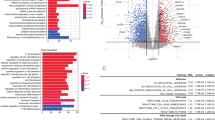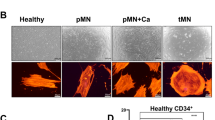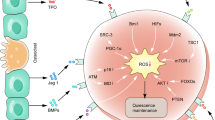Abstract
Chronic lymphocytic leukemia (CLL) cells depend on microenvironmental non-malignant cells for survival. We compared the transcriptomes of primary CLL cells cocultured or not with protective bone marrow stromal cells (BMSCs) and found that oxidative phosphorylation, mitochondrial function, and hypoxic signaling undergo most significant dysregulation in non-protected CLL cells, with the changes peaking at 6–8 h, directly before induction of apoptosis. A subset of CLL patients displayed a gene expression signature resembling that of cocultured CLL cells and had significantly worse progression-free and overall survival. To identify drugs blocking BMSC-mediated support, we compared the relevant transcriptomic changes to the Connectivity Map database. Correlation was found with the transcriptomic signatures of the cardiac glycoside ouabain and of the ipecac alkaloids emetine and cephaeline. These compounds were highly active against protected primary CLL cells (relative IC50's 287, 190, and 35 nM, respectively) and acted by repressing HIF-1α and disturbing intracellular redox homeostasis. We tested emetine in a murine model of CLL and observed decreased CLL cells in peripheral blood, spleen, and bone marrow, recovery of hematological parameters and doubling of median survival (31.5 vs. 15 days, P = 0.0001). Pathways regulating redox homeostasis are thus therapeutically targetable mediators of microenvironmental support in CLL cells.
This is a preview of subscription content, access via your institution
Access options
Subscribe to this journal
Receive 12 print issues and online access
$259.00 per year
only $21.58 per issue
Buy this article
- Purchase on Springer Link
- Instant access to full article PDF
Prices may be subject to local taxes which are calculated during checkout






Similar content being viewed by others
References
Shustik C, Bence-Bruckler I, Delage R, Owen CJ, Toze CL, Coutre S. Advances in the treatment of relapsed/refractory chronic lymphocytic leukemia. Ann Hematol. 2017;96:1185–96.
Ten Hacken E, Burger JA. Microenvironment interactions and B-cell receptor signaling in chronic lymphocytic leukemia: implications for disease pathogenesis and treatment. Biochim Biophys Acta. 2016;1863:401–413.
Thompson PA, Wierda WG. Eliminating minimal residual disease as a therapeutic end point: working toward cure for patients with CLL. Blood. 2016;127:279–86.
Bhattacharya N, Diener S, Idler IS, Rauen J, Habe S, Busch H, et al. Nurse-like cells show deregulated expression of genes involved in immunocompetence. Br J Haematol. 2011;154:349–56.
Burger JA. The CLL cell microenvironment. Adv Exp Med Biol. 2013;792:25–45.
Burkle A, Niedermeier M, Schmitt-Graff A, Wierda WG, Keating MJ, Burger JA. Overexpression of the CXCR5 chemokine receptor, and its ligand, CXCL13 in B-cell chronic lymphocytic leukemia. Blood. 2007;110:3316–25.
Ghia P, Strola G, Granziero L, Geuna M, Guida G, Sallusto F, et al. Chronic lymphocytic leukemia B cells are endowed with the capacity to attract CD4+, CD40L+T cells by producing CCL22. Eur J Immunol. 2002;32:1403–13.
Patten PE, Buggins AG, Richards J, Wotherspoon A, Salisbury J, Mufti GJ, et al. CD38 expression in chronic lymphocytic leukemia is regulated by the tumor microenvironment. Blood. 2008;111:5173–81.
Burger JA. Nurture versus nature: the microenvironment in chronic lymphocytic leukemia. Hematol/Educ Program Am Soc Hematol Am Soc Hematol Educ Program. 2011;2011:96–103.
Stevenson FK, Krysov S, Davies AJ, Steele AJ, Packham G. B-cell receptor signaling in chronic lymphocytic leukemia. Blood. 2011;118:4313–20.
Byrd JC, Brown JR, O’Brien S, Barrientos JC, Kay NE, Reddy NM, et al. Ibrutinib versus ofatumumab in previously treated chronic lymphoid leukemia. New Engl J Med. 2014;371:213–23.
Furman RR, Sharman JP, Coutre SE, Cheson BD, Pagel JM, Hillmen P, et al. Idelalisib and rituximab in relapsed chronic lymphocytic leukemia. New Engl J Med. 2014;370:997–1007.
Chan DA, Sutphin PD, Yen SE, Giaccia AJ. Coordinate regulation of the oxygen-dependent degradation domains of hypoxia-inducible factor 1 alpha. Mol Cell Biol. 2005;25:6415–26.
Liberzon A, Birger C, Thorvaldsdottir H, Ghandi M, Mesirov JP, Tamayo P. The Molecular Signatures Database (MSigDB) hallmark gene set collection. Cell Syst. 2015;1:417–25.
Stilgenbauer S, Schnaiter A, Paschka P, Zenz T, Rossi M, Dohner K, et al. Gene mutations and treatment outcome in chronic lymphocytic leukemia: results from the CLL8 trial. Blood. 2014;123:3247–54.
Lamb J, Crawford ED, Peck D, Modell JW, Blat IC, Wrobel MJ, et al. The Connectivity Map: using gene-expression signatures to connect small molecules, genes, and disease. Science. 2006;313:1929–35.
Iorio F, Tagliaferri R, di Bernardo D. Identifying network of drug mode of action by gene expression profiling. J Comput Biol: J Comput Mol Cell Biol. 2009;16:241–51.
Valsecchi R, Coltella N, Belloni D, Ponente M, Ten Hacken E, Scielzo C, et al. HIF-1alpha regulates the interaction of chronic lymphocytic leukemia cells with the tumor microenvironment. Blood. 2016;127:1987–97.
Gutscher M, Sobotta MC, Wabnitz GH, Ballikaya S, Meyer AJ, Samstag Y, et al. Proximity-based protein thiol oxidation by H2O2-scavenging peroxidases. J Biol Chem. 2009;284:31532–40.
Auletta AE, Gery AM, Mead JA. Influence of antileukemic (L1210) treatment schedule on disposition of (minus)-emetine hydrochloride (NSC 33669) in normal and leukemic mice. Cancer Res. 1974;34:1581–5.
Johnson RK, Jondorf WR. Some inhibitory effects of (–)-emetine on growth of Ehrlich ascites carcinoma. Biochem J. 1974;140:87–94.
Paggetti J, Haderk F, Seiffert M, Janji B, Distler U, Ammerlaan W, et al. Exosomes released by chronic lymphocytic leukemia cells induce the transition of stromal cells into cancer-associated fibroblasts. Blood. 2015;126:1106–17.
Sivina M, Hartmann E, Vasyutina E, Boucas JM, Breuer A, Keating MJ, et al. Stromal cells modulate TCL1 expression, interacting AP-1 components and TCL1-targeting micro-RNAs in chronic lymphocytic leukemia. Leukemia. 2012;26:1812–20.
Edelmann J, Klein-Hitpass L, Carpinteiro A, Fuhrer A, Sellmann L, Stilgenbauer S, et al. Bone marrow fibroblasts induce expression of PI3K/NF-kappaB pathway genes and a pro-angiogenic phenotype in CLL cells. Leuk Res. 2008;32:1565–72.
Schulz A, Toedt G, Zenz T, Stilgenbauer S, Lichter P, Seiffert M. Inflammatory cytokines and signaling pathways are associated with survival of primary chronic lymphocytic leukemia cells in vitro: a dominant role of CCL2. Haematologica. 2011;96:408–16.
Carew JS, Nawrocki ST, Xu RH, Dunner K, McConkey DJ, Wierda WG, et al. Increased mitochondrial biogenesis in primary leukemia cells: the role of endogenous nitric oxide and impact on sensitivity to fludarabine. Leukemia. 2004;18:1934–40.
Jitschin R, Hofmann AD, Bruns H, Giessl A, Bricks J, Berger J, et al. Mitochondrial metabolism contributes to oxidative stress and reveals therapeutic targets in chronic lymphocytic leukemia. Blood. 2014;123:2663–72.
Zhang W, Trachootham D, Liu J, Chen G, Pelicano H, Garcia-Prieto C, et al. Stromal control of cystine metabolism promotes cancer cell survival in chronic lymphocytic leukaemia. Nat Cell Biol. 2012;14:276–86.
Jitschin R, Braun M, Qorraj M, Saul D, Le Blanc K, Zenz T, et al. Stromal cell-mediated glycolytic switch in CLL cells involves Notch-c-Myc signaling. Blood. 2015;125:3432–6.
Chang TS, Cho CS, Park S, Yu S, Kang SW, Rhee SG. Peroxiredoxin III, a mitochondrion-specific peroxidase, regulates apoptotic signaling by mitochondria. J Biol Chem. 2004;279:41975–84.
Soni S, Padwad YS. HIF-1 in cancer therapy: two decade long story of a transcription factor. Acta Oncol. 2017;56:503–15.
Perne A, Muellner MK, Steinrueck M, Craig-Mueller N, Mayerhofer J, Schwarzinger I, et al. Cardiac glycosides induce cell death in human cells by inhibiting general protein synthesis. PLoS ONE. 2009;4:e8292.
Grollman AP. Inhibitors of protein biosynthesis. V. Effects of emetine on protein and nucleic acid biosynthesis in HeLa cells. J Biol Chem. 1968;243:4089–94.
Stenkvist B, Bengtsson E, Dahlqvist B, Eriksson O, Jarkrans T, Nordin B. Cardiac glycosides and breast cancer, revisited. New Engl J Med. 1982;306:484.
Haux J, Klepp O, Spigset O, Tretli S. Digitoxin medication and cancer; case control and internal dose-response studies. BMC Cancer. 2001;1:11.
Johansson S, Lindholm P, Gullbo J, Larsson R, Bohlin L, Claeson P. Cytotoxicity of digitoxin and related cardiac glycosides in human tumor cells. Anti-cancer Drugs. 2001;12:475–83.
Zhou Y, Hileman EO, Plunkett W, Keating MJ, Huang P. Free radical stress in chronic lymphocytic leukemia cells and its role in cellular sensitivity to ROS-generating anticancer agents. Blood. 2003;101:4098–104.
Zhang H, Qian DZ, Tan YS, Lee K, Gao P, Ren YR, et al. Digoxin and other cardiac glycosides inhibit HIF-1alpha synthesis and block tumor growth. PNAS. 2008;105:19579–86.
Howard AN, Bridges KA, Meyn RE, Chandra J. ABT-737, a BH3 mimetic, induces glutathione depletion and oxidative stress. Cancer Chemother Pharmacol. 2009;65:41–54.
Wilkins HM, Marquardt K, Lash LH, Linseman DA. Bcl-2 is a novel interacting partner for the 2-oxoglutarate carrier and a key regulator of mitochondrial glutathione. Free Radic Biol Med. 2012;52:410–9.
Zimmermann AK, Loucks FA, Schroeder EK, Bouchard RJ, Tyler KL, Linseman DA. Glutathione binding to the Bcl-2 homology-3 domain groove: a molecular basis for Bcl-2 antioxidant function at mitochondria. J Biol Chem. 2007;282:29296–304.
Simonetti G, Bertilaccio MT, Ghia P, Klein U. Mouse models in the study of chronic lymphocytic leukemia pathogenesis and therapy. Blood. 2014;124:1010–9.
McClanahan F, Hanna B, Miller S, Clear AJ, Lichter P, Gribben JG, et al. PD-L1 checkpoint blockade prevents immune dysfunction and leukemia development in a mouse model of chronic lymphocytic leukemia. Blood. 2015;126:203–11.
Jondorf WR, Abbott BJ, Greenberg NH, Mead JA. Increased lifespan of leukemic mice treated with drugs related to (-)-emetine. Chemotherapy. 1971;16:109–29.
Boon-Unge K, Yu Q, Zou T, Zhou A, Govitrapong P, Zhou J. Emetine regulates the alternative splicing of Bcl-x through a protein phosphatase 1-dependent mechanism. Chem Biol. 2007;14:1386–92.
Akinboye ES, Bakare O. Biological activities of emetine. Open Nat Prod J. 2011;4:8–15.
Moller M, Wink M. Characteristics of apoptosis induction by the alkaloid emetine in human tumour cell lines. Planta Med. 2007;73:1389–96.
Gupta RS, Chopra A, Stetsko DK. Cellular basis for the species differences in sensitivity to cardiac glycosides (digitalis). J Cell Physiol. 1986;127:197–206.
Calderon-Montano JM, Burgos-Moron E, Lopez-Lazaro M. The in vivo antitumor activity of cardiac glycosides in mice xenografted with human cancer cells is probably an experimental artifact. Oncogene. 2014;33:2947–8.
Acknowledgements
Fabienne McClanahan (Barts Cancer Institute, Queen Mary University of London, UK) provided precious advice regarding the use of the in vivo disease model. The authors are immensely thankful also to Linda Jannetti, Sandra Richter, and Daniela Steinbrecher for their invaluable help in conducting the animal experiments, as well as to Karin Müller, Ellen Scheidhauer, and Nina Urban (all at the Department of Internal Medicine III, University Clinic Ulm) for the excellent technical assistance. In addition, we would like to thank the patients for generous donation of their blood samples. This work was supported by grants from the Deutsche José Carreras Leukämie-Stiftung (DJCLS 14R/2016), the Virtual Helmholtz Institute “Resistance against Apoptotis and Therapy” (VH-VI-404), DFG D-A-CH (ME 3667/3-1), the DFG SFB1074 projects B1/B2, and the Else Kröner Fresenius Stiftung (2012_A146). VC would like to thank for the support of the International Graduate School in Molecular Medicine Ulm at Ulm University, Germany.
Funding
D.M. secured financial support for the study through grants from the Deutsche José Carreras Leukämie-Stiftung (DJCLS 14R/2016), the Virtual Helmholtz Institute “Resistance against Apoptotis and Therapy” (VH-VI-404), DFG D-A-CH (ME 3667/3-1), the DFG SFB1074 projects B1/B2, and the Else Kröner Fresenius Stiftung (2012_A146).
Author information
Authors and Affiliations
Corresponding author
Ethics declarations
Conflict of interest
The authors declare that they have no conflict of interest.
Additional information
Publisher’s note: Springer Nature remains neutral with regard to jurisdictional claims in published maps and institutional affiliations.
Supplementary information
Rights and permissions
About this article
Cite this article
Yosifov, D.Y., Idler, I., Bhattacharya, N. et al. Oxidative stress as candidate therapeutic target to overcome microenvironmental protection of CLL. Leukemia 34, 115–127 (2020). https://doi.org/10.1038/s41375-019-0513-x
Received:
Revised:
Accepted:
Published:
Issue Date:
DOI: https://doi.org/10.1038/s41375-019-0513-x
This article is cited by
-
Dynamic hydrogen peroxide levels reveal a rate-dependent sensitivity in B-cell lymphoma signaling
Scientific Reports (2024)
-
Prognostic value of amino acid metabolism-related gene expression in invasive breast carcinoma
Journal of Cancer Research and Clinical Oncology (2023)
-
Emetine, a small molecule natural product, displays potent anti-gastric cancer activity via regulation of multiple signaling pathways
Cancer Chemotherapy and Pharmacology (2023)
-
Targeting metabolic reprogramming in chronic lymphocytic leukemia
Experimental Hematology & Oncology (2022)
-
Ascorbic acid (vitamin C) synergistically enhances the therapeutic effect of targeted therapy in chronic lymphocytic leukemia
Journal of Experimental & Clinical Cancer Research (2020)



